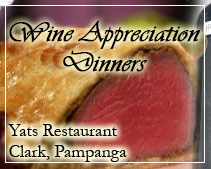A Taste Drive through Pampanga
Pampanga has always enjoyed the title the ‚Äúculinary center of the Philippines.‚ÄĚ This is hard to contend for their food is prepared and cooked with much passion using only the best of ingredients. Being a Kapampangan is almost synonymous to being an excellent cook. Such reputation goes way back during the Spanish colonial times. Pampanga then was one of the largest and richest province in the Philippines. It was one of the main sources of food for the country. Its produce was so abundant that the Manila government required the region to pay tribute in the form of food. So Pampanga sent chickens, rice, sugar and other produce in such large quantities that oftentimes the friars sent back the surplus. This abundance, plus the fresh water fish from the Pampanga River contributed to the development of Pampango cuisine, as we know it today.
Although, the Spaniards were just then a mere two percent of the population, their presence affected the local cuisine. Being great lovers of good food themselves, this two- percent ruled the Philippines and therefore told the people what to do. Since it was a society where the white people were the superior, foreign food was regarded to be chic and exclusive. The natives acquired the basic knowledge of Spanish cuisine from their association with the colonial masters. They quickly learned and in the process adopted the Spanish food using all local ingredients. Take for an instance, the famous turron de casuy from Sta. Rita. It is made of cashew nuts and sugar wrapped in thin paper-like wafer. It is the local version of the Spanish turron alicante, a sweet hard nougat made of honey and almonds. The Spanish paella, also has a local counterpart, the bringhe. Like the paella, it is also cooked with rice, but this time the sticky variety or malagkit, chicken, pork and peas with coconut milk turmeric added to give it a greenish yellow color.
Pampango food like most dishes in the Philippines is Spanish inspired but differs noticeably from those of the other regions. Generally speaking, Pampango food is more exotic, imaginative and fancy. Perhaps what makes the Pampango food distinctive is that Pampangos do not scrimp on ingredients. They love sauces (tiltilan) and it is common to have one dish served with as much as three different sauces or accompaniments to suit one’s individual taste. Another thing also is the patient and tedious way of their cooking. The ordinary mongo (mung beans) soup for example, is also cooked in other regions. But only in Pampanga is the mongo not just boiled and sauteed with shrimps but mashed to a very smooth and thick consistency, then topped with crushed chicharon (pork cracklings) and young ampalaya (bitter melon) leaves.
Pampanga sweets and desserts are also famous. This is no surprise as Pampanga is a sugar-producing region. Vast tracts or haciendas are devoted solely to sugar. Pampanga sweets are more refined and mostly of European influence. The famous sans rival, turrones de casuy, brazo de mercedes and leche flan (caramel custard) are just to name a few.
If you are to attend a town fiesta, you will be served a different kind of cuisine. You will not find the usual or the pang- aldo aldo (everyday fare) but tables will instead be laden with the so-called pang-piesta (fiesta fare). On such occasions, rich Pampangos usually hire local famous cooks a week in advance in preparation. Labor intensive dishes like the galantina, and the Spanish influenced dishes like the paella, lengua, estofado, etc. will surely be on the menu. It is the joy of the Kapampangan host to serve its guests and to refuse his food would seem like an insult.
The warm hospitality of the Kapampangans complements their great talent in cooking. The common greeting in a Pampanga home, is ‚ÄúMengan naka‚ÄĚ which means ‚ÄúHave you eaten? It is true that Pampangos live to eat.
Just Some of Pampango’s many famous dishes:
Buro is fermented rice with fish or small shrimps (a.k.a. balo-balo). It is served as an accompaniment for fried or grilled fish (best with crispy hito or catfish) and boiled vegetables such as eggplant, okra, ampalaya (bitter gourd) and fresh mustard leaves. A very typical Kapampangan dish and a must-try delicacy.
Betute is stuffed frog. The humble frog is stuffed with ground and seasoned pork, then deep-fried to a perfect crisp.
Kamaru is probably the most exotic and hardest to find Kapampangan food. The kamaru or mole crickets are sautéed in garlic and onion, then roasted dry to a crunch. This is certainly not for the squeamish as when served they looked like big ants or small cockroaches. But if you are adventurous and can handle a balot (hardboiled duck egg with a developed embryo), it is highly recommended you try the kamaru, too, if ever you find it. Rich in protein and low in cholesterol, and contrary to its unsightly appearance, it is quite clean as it feeds only on rice and is found in the paddies.
Sisig is pork cheek, grilled to a crunchy perfection, chopped and mixed with chicken liver, onions, kalamansi (native lemon) and spiked with fresh chili.
Bulanglang Kapampangan is basically a complete boiled dish consisting of any or all of the following: shrimp, bangus or milkfish, pork belly, kangkong, gabi, okra and the broth flavored with ripe native guavas.
Pak√ī salad is fiddlehead fern usually grown and served only in private homes.
Batsui is a ginger-flavored soup consisting mainly of pork meat, blood, kidney and misua or fine noodles thrown in.
Kilain is basically a stew of pork meat, liver and lung cooked in vinegar and garlic.
Pindang babi (tocino) or sweet cured and pindang damulag or cured carabeef. No Pampango home is left without a pack or so of this most popular meat delicacy in the freezer ‚Äď always readily available for the unexpected guest. A favorite among visitors as pasalubong.
Burong talangk√Ę is the fat of salt-preserved little crabs. This very tasty rich paste is not for the diet conscious ‚Äď it is laden with cholesterol, but heavenly nonetheless!
Sanikulas is a native biscuit made of arrowroot and coconut milk. It originated as a giveaway by the priest during the feast of San Nicolas Tolentino on September 10, everyone attending the mass receiving one. The biscuits are believed to be miraculous and can cure the sick of any ailment. Nowadays all the religious connotation is gone and are simply savored for their salient taste.
Tibuk-tibok is a pudding-like dessert made of carabao’s milk. Named after the tibok or heartbeat, as the congelation is apt to react when shaken. Also known as majablanca (white lady in Spanish) by the Manilenos.
Some recommended stops:
Everybody’s Café (Mac Arthur Hiighway, City of San Fernando poblacion). A pre-war institution serving the best of Pampango cuisine. Must try are its kamaru (rice crickets), adobong dumara (wild duck), betute, fried hito served with buro and mustasa, morcon and chunky longganisa.
Susie‚Äôs Cuisine (Hilda St., Nepo Mart I, Angeles City) Its oft-imitated but so far never equaled Tibuk-tibok (Majablanca to Manile√Īos) is the best seller. The name tibuk-tibok is derived from the heartbeat-like (tibok ng puso) movement if one is to shake it. Made of fresh carabao‚Äôs milk with a subtle hint of dayap zest, Susie‚Äôs version has a smooth and silken consistency, unlike others which are starchy and lumpy. Its closest foreign counterpart is the Italian pannacotta, but not quite. Other house specialties are pancit luglog, leche flan, haleang ube, mochi and many other pasalubong.
Rosing’s Candies (Hilda St., Nepo Mart I, Angeles City, two stalls away. Not your usual branded candies but could indulge any sweet tooth craving nonetheless. These hand-made delicacies are still made from scratch the old fashion way, slow-cooked with all-natural ingredients. Sold by the piece or by the box, one could get a mixed sampling of the pastillas de leche, caramel, polvoron, yemas, casuy tartlets, empanaditas and many more.
Cely‚Äôs Karinderia ‚Äď (Nepo Mart I, Angeles City, right across Susie‚Äôs) Cely‚Äôs may be basic looking, but it probably serves some of the most authentic Pampango food in this part of town. The place doesn‚Äôt worry about ambience but puts all its efforts into its food. It‚Äôs as home-cooked as home-cooked can be. Signature Pampango dishes like batute (stuffed frogs), balo-balo (fermented rice) and fresh mustard leaves as an accompaniment for grilled hito or tilapia, pak√ī salad (fiddlehead fern), lagat puso (young banana heart), kare-kare (ox-tail in creamy peanut sauce), dinuguan (pig‚Äôs blood and innards stew), etc, are served daily. This may not be the place for the finicky but it‚Äôs definitely worth the gastronomic experience.
Aling Lucing Sisig (by the railroad crossing, Angeles City). To call this joint basic is an understatement. It sits right by the railroad tracks together with a dozen or so food stalls serving basically the same thing ‚Äď a variety of charcoal grilled meats and beer. It‚Äôs grubby, smoke hazing into the air and has zero atmosphere. Tables and benches spill over onto the street. But the house specialty sisig is what made Aling Lucing practically an institution for many years running. Ordinary and upscale folks alike from Manila travel all the way to Angeles just to have a grab of this cholesterol-laden yummy concoction. It is pork cheek, grilled to a crunchy perfection, chopped and mixed with chicken liver, onions, kalamansi (native lemon) and spiked with fresh chili. Other specialties are grilled chicken butts, pig‚Äôs ears and lechon manok (roasted whole chicken.) Not for the squeamish and faint-hearted but highly recommended for the sturdy and adventurous. Open daily from 4 PM until the wee hours.
Kabigting Halo-halo of Arayat, Pampanga (corner Esoino and Mutuc sts, across the big church) What makes this one great is its utter simplicity. The mix consists only of whole kernel sweet corn, mashed white kidney beans (heavenly in itself) and a spoonful of carabao’s milk jalea (to die for, same as pastillas de leche).
Razon of Guagua ‚Äď another serendipitous delight with its offerings of pancit palabok and halo-halo. It version of halo-halo has a simple mix of saging saba, macapuno and topped with leche flan. Started in the 60s by 3 Razon sisters in their house in L&D subdivision, in Guagua, Pampanga. Now run by the third generation, they have branched out in San Fernando and Angeles City (Mac Arthur Highway, near Angeles University).
By Claude Tayag
If this article about Clark is useful to you, please click here to contact us to tell us what more you wish to know about this article or Clark Philippines, which can be something about Clark investment, about Clark resorts, about Clark Swimming and Leisure or simply general news about Clark.
Please send questions to Editor@ClarkPhilippines.com. Leave your name, email address, contact numbers and we will get back to you as soon as possible. Information received will not be disclosed.













